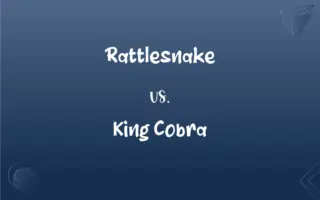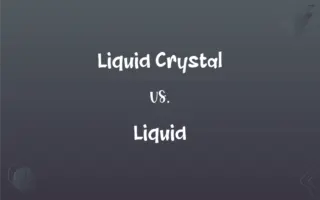Levigation vs. Trituration: What's the Difference?
Edited by Aimie Carlson || By Janet White || Published on February 22, 2024
Levigation is the process of grinding substances into a fine powder with a liquid, while trituration is the grinding or rubbing of substances into fine particles, typically using a mortar and pestle, without necessarily involving a liquid.

Key Differences
Levigation involves the addition of a liquid to aid in the grinding of a substance into a fine powder, making the process more efficient for substances that are difficult to grind dry. Trituration, on the other hand, usually does not involve liquids and focuses solely on the grinding or rubbing action to reduce substances into fine particles.
In levigation, the choice of liquid can vary based on the substance being ground and the desired consistency of the final product. Trituration, in contrast, relies more on the mechanical force applied through grinding tools like a mortar and pestle, with the focus on achieving uniform particle size.
Levigation is often used in pharmaceutical compounding to create smooth suspensions or ointments, where the uniformity of particle size is crucial. Trituration, while also used in pharmaceuticals, is more commonly associated with the preparation of powders for encapsulation or for making tablets.
The technique of levigation can also be applied in the field of ceramics, where it aids in preparing clay and other materials. Trituration, with its emphasis on dry grinding, finds applications in areas like homeopathy and chemistry where dry, fine powders are required.
Levigation is typically used when the end product must be free of any gritty texture, ensuring a smooth consistency. Trituration, due to its dry grinding nature, might result in a slightly coarser product but is preferred when the introduction of liquids might alter the chemical nature of the substance.
ADVERTISEMENT
Comparison Chart
Involvement of Liquid
Involves liquids for grinding
Typically does not involve liquids
End Product
Produces very fine, smooth powders
Results in fine, but possibly coarser powders
Common Usage
Used in pharmaceutical suspensions, ointments
Used in making powders for tablets, encapsulation
Particle Consistency
Ensures uniformity and smoothness
Focuses on uniform size but can be less smooth
Impact on Substance
Can alter chemical nature with liquid
Maintains chemical nature of the substance
ADVERTISEMENT
Technique
Grinding with liquid to aid process
Dry grinding or rubbing action
Levigation and Trituration Definitions
Levigation
Levigation is the process of grinding substances into a fine powder using a liquid.
In the pharmacy, we used levigation to create a smooth ointment.
Trituration
Trituration is the process of grinding a substance into fine particles using mechanical force.
The pharmacist performed trituration to powderize the dried herbs.
Levigation
Levigation aids in creating homogenous mixtures by fine grinding in a liquid.
Levigation helped in preparing the paint to the right consistency.
Trituration
Trituration refers to the fine grinding of substances, often using a mortar and pestle.
The preparation of the homeopathic remedy involved meticulous trituration.
Levigation
Levigation involves producing a uniformly sized particle suspension in a liquid.
Levigation was essential to suspend the active ingredient evenly.
Trituration
Trituration is a technique for obtaining fine powders without adding any liquids.
Trituration of the crystals yielded a fine, consistent powder.
Levigation
Levigation is a technique for processing substances into fine suspensions.
Through levigation, the herbal extract was evenly dispersed in the solution.
Trituration
Trituration involves the reduction of substances to fine particles by rubbing or grinding.
Trituration of the compound was necessary for its absorption.
Levigation
Levigation is used to reduce particle size and improve the texture of a mixture.
The levigation of the clay ensured a smoother pottery finish.
Trituration
Trituration is used in pharmacy to create uniformly sized particles for medicines.
Accurate dosing was achieved through careful trituration of the ingredients.
Levigation
To make into a smooth, fine powder or paste, as by grinding when moist.
Trituration
The act or process of triturating.
Levigation
To separate fine particles from coarse by grinding in water.
Trituration
The composing of a dental amalgam by mortar and pestle.
Levigation
To suspend in a liquid.
Trituration
The act of triturating; grinding to a fine powder.
Levigation
To make smooth; polish.
Trituration
Something triturated, especially dental amalgam.
Levigation
Smooth.
Trituration
The act of triturating, or reducing to a fine or impalpable powder by grinding, rubbing, bruising, etc.
Levigation
The act or operation of levigating.
Levigation
The act or operation of levigating.
FAQs
What is levigation?
It's the process of grinding substances into a fine powder with a liquid.
Can levigation alter the chemical nature of a substance?
Yes, the added liquid in levigation can sometimes alter the chemical nature.
Is levigation used outside pharmacy?
Yes, in fields like ceramics for preparing materials.
Are liquids used in trituration?
No, trituration usually does not involve liquids.
What is trituration?
Trituration is grinding substances into fine particles, typically dry, using mechanical force.
What's the main use of trituration in pharmacy?
It's used for creating fine powders for tablets and encapsulations.
Does levigation require special equipment?
It requires equipment to grind with liquid, like a wet grinder.
Is trituration suitable for ointment preparation?
It's less common, as ointments usually require smoother, finer particles.
Is levigation environmentally friendly?
It depends on the liquid used and disposal methods.
Does trituration produce smoother powders than levigation?
No, trituration might result in slightly coarser powders.
What tools are used in trituration?
A mortar and pestle are commonly used.
Is levigation faster than trituration?
It can be, especially for hard-to-grind substances.
Can trituration create dust hazards?
Yes, especially with dry, fine powders.
Are there any risks with levigation?
Incorrect liquid choice can affect the product's quality or safety.
How precise is trituration in particle size?
Very precise, with uniform particle sizes achievable.
Can levigation be used for making tablets?
Not typically, as it involves liquids and is more suited for suspensions or ointments.
Is levigation suitable for all types of substances?
Not for substances that react or degrade with liquids.
Can trituration be used for liquid formulations?
It's mainly for dry formulations, but the powders can be incorporated into liquids later.
Is training required for effective levigation?
Basic training is advisable for optimal results and safety.
Can trituration be automated?
Yes, with mechanical mills and grinders.
About Author
Written by
Janet WhiteJanet White has been an esteemed writer and blogger for Difference Wiki. Holding a Master's degree in Science and Medical Journalism from the prestigious Boston University, she has consistently demonstrated her expertise and passion for her field. When she's not immersed in her work, Janet relishes her time exercising, delving into a good book, and cherishing moments with friends and family.
Edited by
Aimie CarlsonAimie Carlson, holding a master's degree in English literature, is a fervent English language enthusiast. She lends her writing talents to Difference Wiki, a prominent website that specializes in comparisons, offering readers insightful analyses that both captivate and inform.






































































